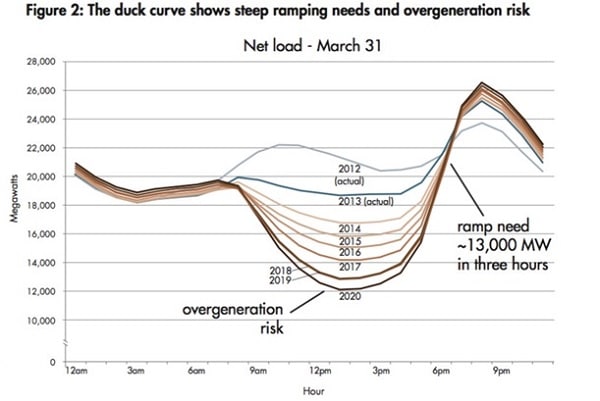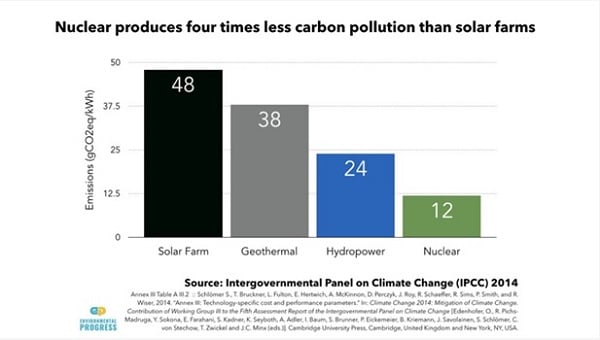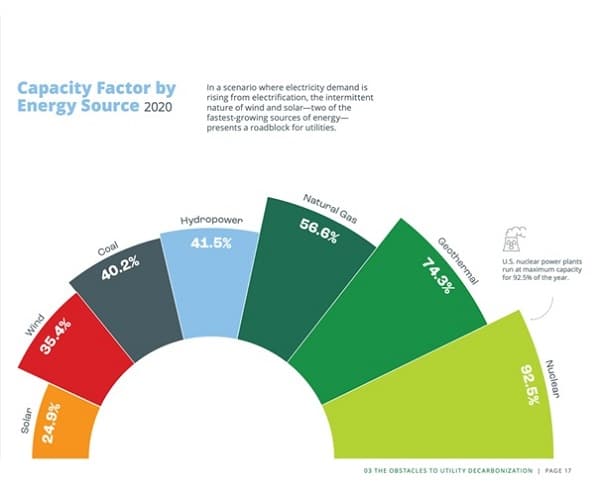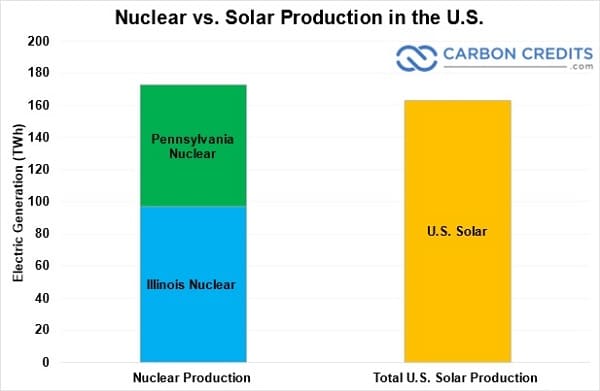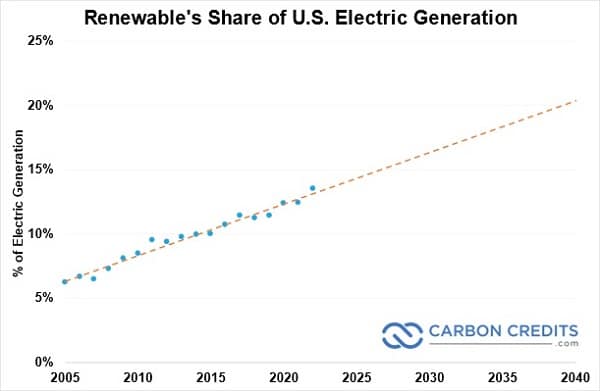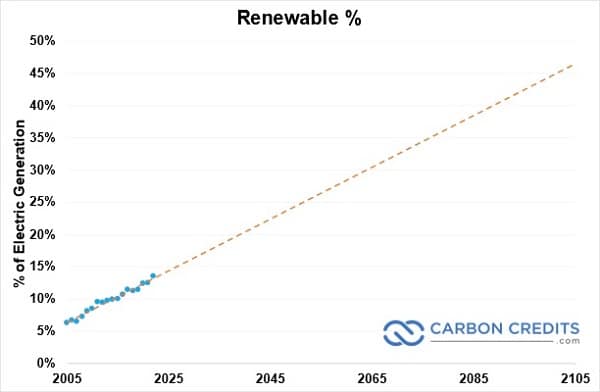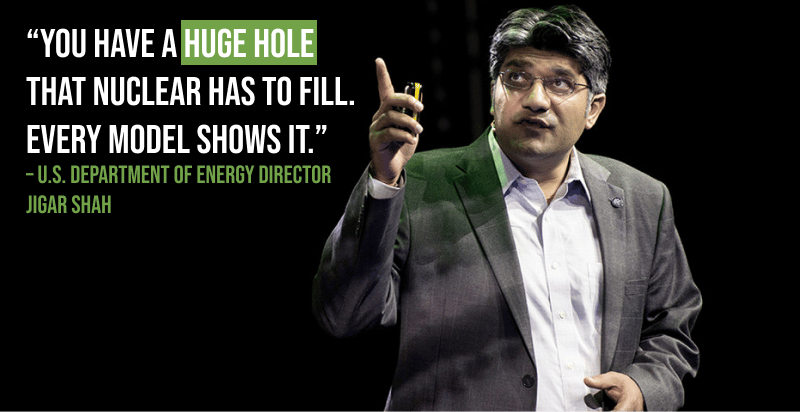Installing wind and solar increases CO2 emissions.
It’s due in part to something called “The Duck Curve.”
This graph shows how much power California needed from everything except solar, by hour of day, for the last decade:
During the day, solar generates so much electricity that nearly all other sources have to shut down. Otherwise, it risks blowing out the grid.
In the evening, when everyone comes home and needs to use power just as the sun is setting, demand for other sources of power spikes off the charts.
Ordinarily, nuclear would provide a consistent source of power throughout the course of the day.
But nuclear can’t just be shut off during the day when solar takes over, and turned back on at night when the sky goes dark.
So coal, oil, and gas plants have to be used to handle the spike.
-
Which means that every solar panel erected requires a fossil fuel plant to work.
Note: Oil and gas companies aren’t stupid. This is exactly why they’re lobbying so heavily for solar and wind.
California is not the only place emissions are rising because renewables are installed. In Germany, the Hambacher Forest is on the verge of being destroyed. Why?
Because it’s sitting on a ton of coal. And since Germany is shutting down nuclear and turning to renewables, it needs to burn more coal to account for peaks in demand.
Sweden thought about replacing its nuclear with wind. It found that every gigawatt of nuclear replaced by wind would require an additional gigawatt of gas-based electricity.
And the buildout would cause Sweden’s CO2 emissions to double.
As renewable energy increases around the world, nuclear plants are forced to shut down…
The same nuclear plants that emit 75 percent less CO2 than solar and 99 percent less than coal.
Oh, and as a bonus—nuclear plants require zero fossil fuel plants in order to run.
Nuclear with uranium doesn’t just win the clean energy and emissions contest with renewables.
In every category that matters to stopping climate change and saving the environment, renewables lose.
Renewables Don’t Hold a Candle to Nuclear
A nuclear reactor can produce about 1 GW of electricity. But that’s not equivalent to 1 GW of installed wind or solar.
Nuclear plants produce energy more than 90 percent of the time. Wind only runs about 35 percent of the time, and solar a measly 25 percent of the time.
That means that three to four times as much wind and solar has to be installed just to produce the same amount of energy as nuclear. Here’s what that difference looks like in real life:
-
Eleven nuclear plants in Illinois and Pennsylvania produced more power than all solar in the U.S. in 2021.
In both land and waste, that makes a huge difference for the environment.
Those eleven plants cover about 25 square miles of land total.
Generating the same amount of electricity via solar requires more than 775 square miles—all of it deforested to make room for solar panels.
And wind? It would take more than 4,000 square miles.
In fact, solar and wind require so much land that countries like Japan would need to cover every last square inch of free land with solar to fully power the country.
But that’s not wind and solar’s biggest problem. Because unlike their name, renewables don’t last forever.
Solar panels have to be replaced every thirty years, resulting in staggering amounts of waste.
The International Renewable Energy Agency expects that by 2050, the world will have accumulated 78 million tons of solar power waste.
- Solar will generate 300 times as much waste by 2050 as nuclear has since 1950.
Wind is no better. More than 720,000 tons of 150-foot blades are expected to be dumped in landfills in the next two decades.
The high material requirements and low capacity of renewables present a little life-threatening problem:
They can never be built fast enough to save the earth.
Rising Tides Sink All Boats
In 1995, 7.2 percent of electricity in the U.S. was generated by renewables. A quarter century later, that had risen to… just 12.4 percent.
It took a twenty-five years to increase renewables as a portion of electricity by five percent.
For the record, it took three years for nuclear to make a similar move, from ’74-’77.
On its current trajectory, it will take renewables another twenty years to catch up to nuclear as a percentage of electricity generation.
And it would take a century for the U.S. to get to 50 percent renewables.
In fact, renewables aren’t even covering increases in demand right now.
- Global energy demand increased by 600 percent more than renewable energy consumption in 2021.
In an open letter, professors at MIT, Columbia, and the Carnegie Institution wrote:
Renewables… cannot scale up fast enough to deliver cheap and reliable power at the scale the global economy requires….
In the real world, there is no credible path to climate stabilization that does not include a substantial role for nuclear power.
The OECD agrees. It projects that to meet emissions goals, nuclear needs to produce 9,000 TWh a year by 2050, which will cost about $8 trillion.
That’s assuming wind and solar can produce about the same amount of energy by then… at a cost of about $20 trillion.
The world would save $12 trillion by using nuclear instead of renewables.
It doesn’t matter what angle it is… emissions, waste, land, cost…
In the fight against climate change, nuclear is the only renewable worth a watt.
Our Newest Renewable
Yes, nuclear is a renewable—arguably the only real renewable other than hydro.
Unlike wind and solar, nuclear generates the only waste from electricity production that is safely contained.
And used nuclear fuel still has about a hundred times more energy than was extracted from it. Reprocessing that fuel enables it to be used again… and again.
France, Russia, and Japan already re-use their nuclear fuel, getting more energy out of it each time.
As additional reactors that can use reprocessed fuel come online, nuclear waste will become worth billions of dollars.
Fourth-generation nuclear reactors called “breeders” could extract almost all of the energy from uranium—99x more than is currently used—without the fuel ever leaving the reactor.
There are also about 4.5 billion tons of uranium floating in the ocean.
When uranium is extracted from seawater for clean energy production, more uranium is leached from rocks to replace it to the same concentration.
And those rocks hold 100 trillion tons of uranium, a super massive source of clean energy.
- So if nuclear provided 100 percent of earth’s energy for a billion years… uranium wouldn’t run out.
That makes it roughly as renewable as solar and wind.
Only with minimal waste, small land requirements, and zero additional CO2 emissions.
Governments are already recognizing that uranium is a clean, renewable source of energy.
The EU has taken the first step, stating that nuclear power will qualify as a green investment starting in 2023.
The state of Utah passed their Renewable Energy Development Act, which defined nuclear power as a form of renewable energy.
As nuclear gains renewable status, utilities will be able to use it to meet their renewable electricity regulations.
Policies will change, and massive tax incentives will be rolled out to build nuclear power plants. Uranium will be on top of the clean energy options.
And soon—unlike with wind and solar—the world’s CO2 emissions will begin to fall.

